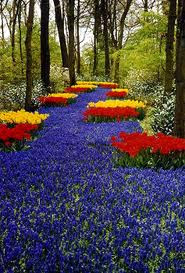 Nowadays
the word "bamboo" is refer to two different types of plants. On the
one hand there are all the species belonging to the subfamily Bambusoideae
(about 1200 species) and on the other hand the sp. Dracaena sanderiana which taxonomically it doesn't nothing to do with the
first group. The assignement of "bamboo" is only correct for the
first group. This entry is specially dedicated to the species of the subfamily
Bambusoideae, although at the end we'll talk about Dracaena sanderiana, also
called "Lucky bamboo".
Nowadays
the word "bamboo" is refer to two different types of plants. On the
one hand there are all the species belonging to the subfamily Bambusoideae
(about 1200 species) and on the other hand the sp. Dracaena sanderiana which taxonomically it doesn't nothing to do with the
first group. The assignement of "bamboo" is only correct for the
first group. This entry is specially dedicated to the species of the subfamily
Bambusoideae, although at the end we'll talk about Dracaena sanderiana, also
called "Lucky bamboo".
The
subfamily Bambusoideae belongs to the extensive Poaceae family. Generally this
Subfamily owns herbaceous, woody, cold-resistant and evergreen plants. Their
distribution includes the tropical areas of the planet although this type of
plants can adapt to other climates. They have green and pseudopeciolated
leaves. They flower with very irregular cycles, so it's very unfrequent to see
these plants flowering. This subfamily i divided in 2 groups (or supertribes) :
Olyredae.
The minority of the generes are in this group.
Bambusodae.
This group owns the most of the generes. The most important generes are:
-Bambusa:
It has around 100 species like B.vulgaris. The stem is yellow whith green lines
and the leaves are green. It can be 12 m tall, the shoots are edible, with reminelalizing and laxative properties. Also they are very used in order to control the erosion of
the lands.
-Chusquea:
It has around 120 species originaries of Soth America. Their stem are solid.
Some species are C.culeou and C.quita.
-Arundinaria:
(around 50).They are originary of China and North America. The leaves are long,
lanceolated and flexible. Some species are A.densiflora and A.japonica.
-Phyllostachys:(around
45) Originary of East Asia. The most important species are:
*P.aurea/bambusoides: Also called
"Golden bamboo" because of the yellow colour of the stem. It is udes
as ornamental, support and edible plant.
*P.edulis: Also called "Moso
bamboo". It occupies 2/3 of the total bamboo population of China. Its main
use is as food plant (the stems and the shoots)
*P.nigra: Also called "Black
bamboo" because of its black stem. Its leaves are dark green and bright.
It is used in ornamentation and nowadays there are lots of varieties.
These
plants usually grow in gregarious groups, and sometimes making forests. In Asia
8specially in China) these forsts are very characteristic beacause of it
singularity and beauty , and very important because they occupy around 20.000
km2. And bamboo
is the main food of the panda's diet.
The
Dracaena sanderiana is known incorrectly as "Bamboo"
because of the similarity of its stem to the stem of the species of the
subfamily Bambusoideae. This sp. belongs to Agavaceae family and it's also called
"Lucky bamboo" because according to the Chinese Feng Shui
"pseudoscienece" this plant brings good luck wherever you place it,
although its origin is African.
This
plant is being more and more known around the world and used at ornamentation
due to its easy care and its beauty appearance.
From
the node sprouts the leaves, and from the internode sprouts the roots.
Its
ideal temperature is around 20-25ºC.It
needs a great amount of light, but in an indirect way. The most common plagues
are cochineal and fungus.
¿Why have I chosen this plant?
This
plant attracted my attention long time ago. I think that bamboo is a curious
plant because of its stems, which have an uncommon structure. And apart from
that fact, I would like to explain the difference between the 2 types of
bamboo,specifyng which is the true bamboo and which is the "false"
due to the last is becoming more and more popular in our homes.
















